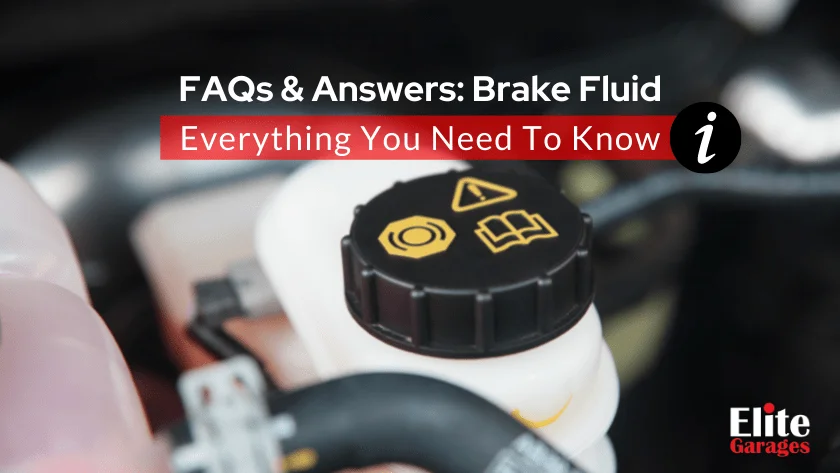
How Do I Know If My Brake Fluid Needs Replacing?
The brakes in your car use brake fluid which is vital for several reasons. Not only does it place hydraulic force through the brake callipers but it also lubricates the internal parts to ensure longevity and performance. Without brake fluid, you will have no brakes and that is a recipe for disaster. In this simple guide, we explain how the system works, what signs to look out for and how to change your fluid.
How Do My Car Brakes Work?
Aside from the inner mechanical workings, your car brakes are pretty straightforward. When pressure is applied to the brake pedal, the brake fluid’s pressurised system mechanically or electronically pushes a piston through the master cylinder. From here, it pushes fluid to the callipers which will push the brake pads onto the brake disc. It’s this friction that reduces the speed of your vehicle and allows you to come to a safe stop.
How Long Does Brake Fluid Last?
It’s a popular question but there’s no definitive answer as it’s different for every car. However, most manufacturers suggest a brake fluid replacement service at least every four to five years but sometimes sooner. Driving habits can play a part as well as poorly maintained brakes and overall vehicle condition.
Remember, even though the fluid is inside a sealed system, moisture can still find a way in. It can corrode components over time and lower the temperature at which the fluid is supposed to boil. You also have to take into consideration the wear of internal brake components and debris contaminating the fluid which can clog up the entire system.
As you can imagine, all of this can affect the performance of your brakes, especially if you drive in constant stop-start traffic with heavy braking. Here are a few interesting things you may not have known about your brakes.
How Do I Check My Brake Fluid?
Checking your car brakes and fluid regularly should form part of any preventative maintenance plan. It allows you to identify potential problems before they impact your braking abilities. If you’re doing it yourself, here are four steps to follow:
- Make sure your car is parked on level ground and engage the handbrake
- Open the bonnet and secure it
- Find the brake fluid reservoir which is mostly a small, semi-transparent “bottle” behind the steering wheel
- Check the fluid level by making sure it’s between the MIN and MAX marks on the reservoir.
The colour of the fluid should be light golden brown if it’s still usable. If it’s under the MIN mark, it’s time to book your brake fluid replacement service. A drop in the level could indicate worn brake linings or a leak from the hydraulic system.
How Do I Know My Fluid Needs Replacing?
Besides looking at the fluid level in the reservoir, there are several tell-tale signs that your car might need new brake fluid or a top-up:
- If the brakes feel in any way different in terms of not functioning properly
- When the brakes feel spongy when pressing down the pedal
- New fluid has a light amber colour so if it’s anything else, take note and visit your nearest Elite Garage for a free brake check
- A darkening in colour is a sign of contamination so the need to change it increases
- If the fluid becomes darker than brown, or even black, you should change it immediately
Recommended: ‘What Are The Main Types Of Brake Fluids?’
How Can I Get My Brake Fluid Replaced?
Checking your fluid level is the easy part but replacing it is more complex. We highly recommend using a trained professional as not all vehicles are the same and often require a different process.
Considering how important brake fluid is in keeping your car safe on the road, make sure you get it replaced if you notice any of the aforementioned signs. When done at a reputable service centre, the service can be done within 30 minutes, depending on the vehicle and if there aren’t any issues.
At Elite Garages, our trained technicians are here to help in any way they can. Whether you’re in Brighton, Portsmouth, Salisbury, Horsham, Southampton or Maidstone, we’ve got you covered with 14 branches across the country. If you need a brake fluid replacement, contact your nearest branch or complete the online form for a free brake check.
About Us
Opening Times
Saturday : 8:30–4:00
Sunday : closed
More Information
Contact UsCustomer Information Pack
Check MOT Due Date
Free MOT reminder
Careers
Legal Information
Recent Posts
- The Most Common Car Questions UK Drivers Ask, And What They Usually Mean
- Why Short Winter Journeys Cause So Many Common Car Problems
- Why Car Problems Happen More Often in January (And What Drivers Miss)
- Why the Right Car Service Garage Matters: Advice Drivers Trusted Most in 2025
- Christmas Guide to Winter Car Checks: From All of Us at Elite Garages


